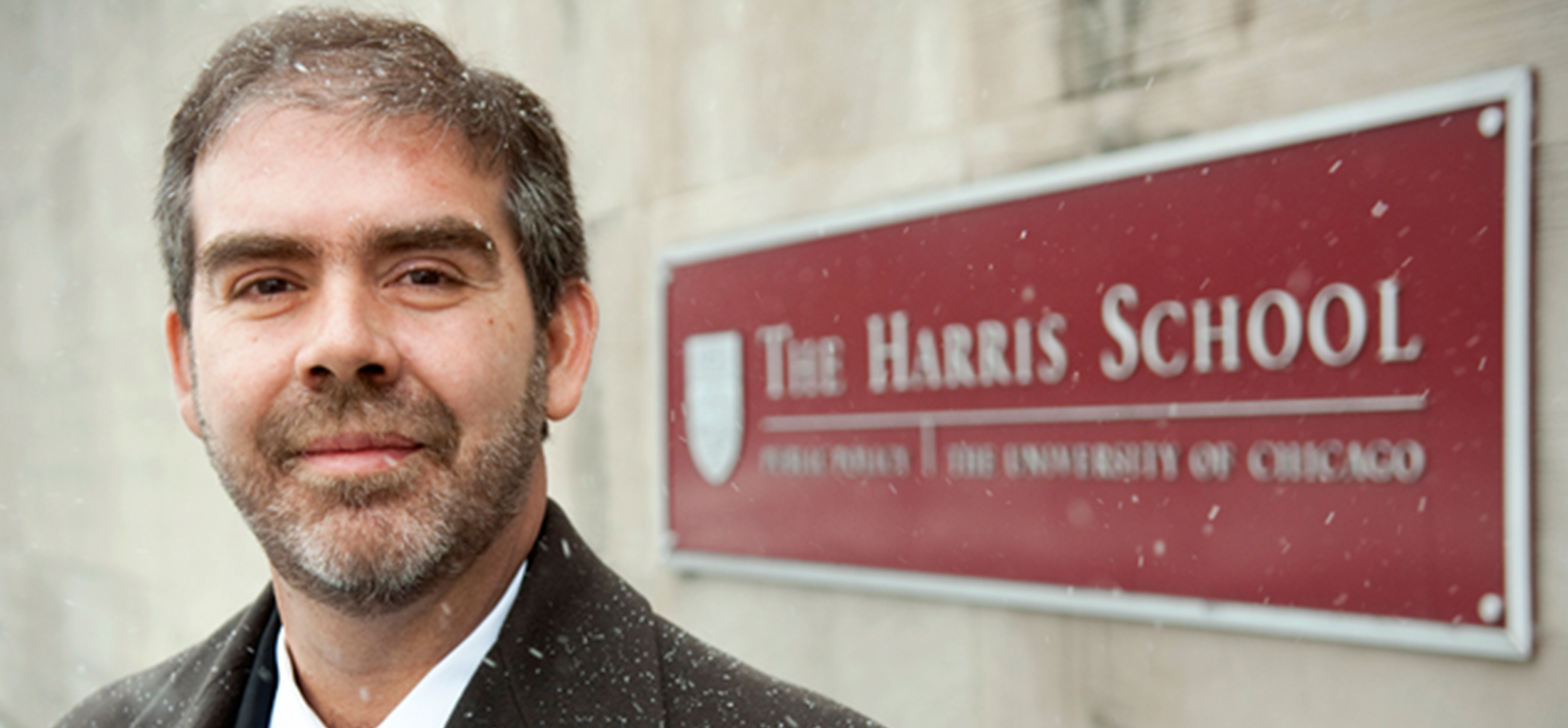
In Mexico, Garcia-Junco says, health care is seen as a “fundamental right.” (Photo by Lloyd Degrane)
Mexico’s universal health care is both an achievement and a work in progress.
After David Garcia-Junco Machado, AM’95, wrapped up his presentation on Mexico’s newly achieved universal health coverage, one student raised his hand and asked what the main difference was between the health system in Mexico and in the United States. Garcia-Junco smiled. “In general terms,” he said, “in Mexico we think health care is a fundamental right. And that the government has to pay for it.”
Ten years ago, one in two Mexicans—more than 50 million people—had no medical coverage at all. A 1980s amendment had carved out health care as a constitutional right, “but we didn’t have it in practice,” said Garcia-Junco, Mexico’s national commissioner for social protection in health, who returned to the Harris School in January to give a talk. Since the 1940s, he explained, most of Mexico’s salaried workers have been insured through a public system called the Mexican Institute for Social Security, which offers health and other “social protection” benefits. In the 1960s a similar agency was set up to provide health insurance to government workers. “For every other Mexican,” Garcia-Junco said—including not only the very poor but also farmers, odd-job laborers, self-employed professionals, and anyone working without a formal salary—“there was no guarantee of any kind of health services.”
Then in 2003, the federal government launched Seguro Popular, a plan whose stated purpose was to fill the gap in universal coverage. By the end of 2011, with 52 million Mexicans enrolled, the country reached that goal, said Garcia-Junco. Any Mexican can join Seguro Popular. “All they have to do is ask for it.” The package guarantees a wide range of basic medical services and offers coverage for more than 80 percent of catastrophic illnesses. For children up to five years old, the system covers every medical need. With a budget last year of $12 billion, it is funded mainly by the country’s general tax revenues. Both the federal and state governments contribute, and all but Mexico’s poorest Seguro Popular members also pay into the plan, based on a percentage of their income.
Because of Seguro Popular, the past eight years have seen massive changes in the health-care infrastructure. Since 2005, Garcia-Junco said, the government has built more than 4,000 hospitals, clinics, and mobile medical units. “Eight years ago, we had only three high-specialty centers in Mexico. If you had some complicated disease that you needed highly specialized medical services for, you had to go to Mexico City, Guadalajara, or to Monterrey.” Today the country has 12 highly specialized medical centers.
Already the plan is saving lives. Garcia-Junco talked about the 20,000 women who’ve received breast-cancer treatment, the children cured of leukemia, diabetics and hypertensive patients who’ve been diagnosed and treated. Some of Seguro Popular’s poorest enrollees had never had a checkup before joining the plan, had never visited a doctor. Now they receive physical exams at least every three years.
Still, plenty of challenges lie ahead, Garcia-Junco said, and the task of insuring so many people is enormous. Especially in the poorest states, medical care can be uneven, and waiting times long. Meanwhile, he said, “we have universal health-care coverage, but in three different fragmented systems”—Seguro Popular and the two agencies that preceded it. “We should have one.”
During the Q&A that followed Garcia-Junco’s talk, students asked about the complexities of enrolling rural peasants with no IDs. One solution is biometric identification, Garcia-Junco said. “We cannot leave people without health care because the other institutions”—census and revenue agencies—“cannot count the Mexicans.”
Another student asked about corruption, which has long been a problem for Latin American governments. “Corruption never goes away,” Garcia-Junco said. “The only thing we can do is mitigate some of the problem.” One way, he noted, is to adopt strict federal budgets for equipment and other purchases and delegate the buying to local officials. Say a certain type of computer costs $1,000, he said, offering a hypothetical. The federal government would provide the states with $1,000 per computer, plus maybe ten percent. “If it’s no more than that”—that extra ten percent going into someone’s pocket—“I’m not sure if it’s corruption or not, but we’re going to allow it. I’m pretty sure some people are getting small amounts of money, but they become champions of the Seguro Popular system. And what we need is the system.”
What about Seguro Popular’s long-term economic feasibility? another student asked. “We see wealthy countries have budget problems with universal coverage,” he said. “How can Mexico afford it?” Partly, Garcia-Junco answered, because high-quality medical care is cheaper in Mexico than in wealthier countries, just as a house in Manhattan costs more than the same house in Nevada.
Seguro Popular, he added, is a system, not a program. The distinction matters: “A program, you negotiate the budget every year,” he said. “This is a system, defined by law. And the funding is defined by law.” There will be budgetary pressures, he acknowledged, but Seguro Popular’s basic undertaking remains constant. “The other thing,” he said, is that now “you have 52 million Mexicans that have a policy. Are you willing to tell them next year that they don’t have it anymore?”
